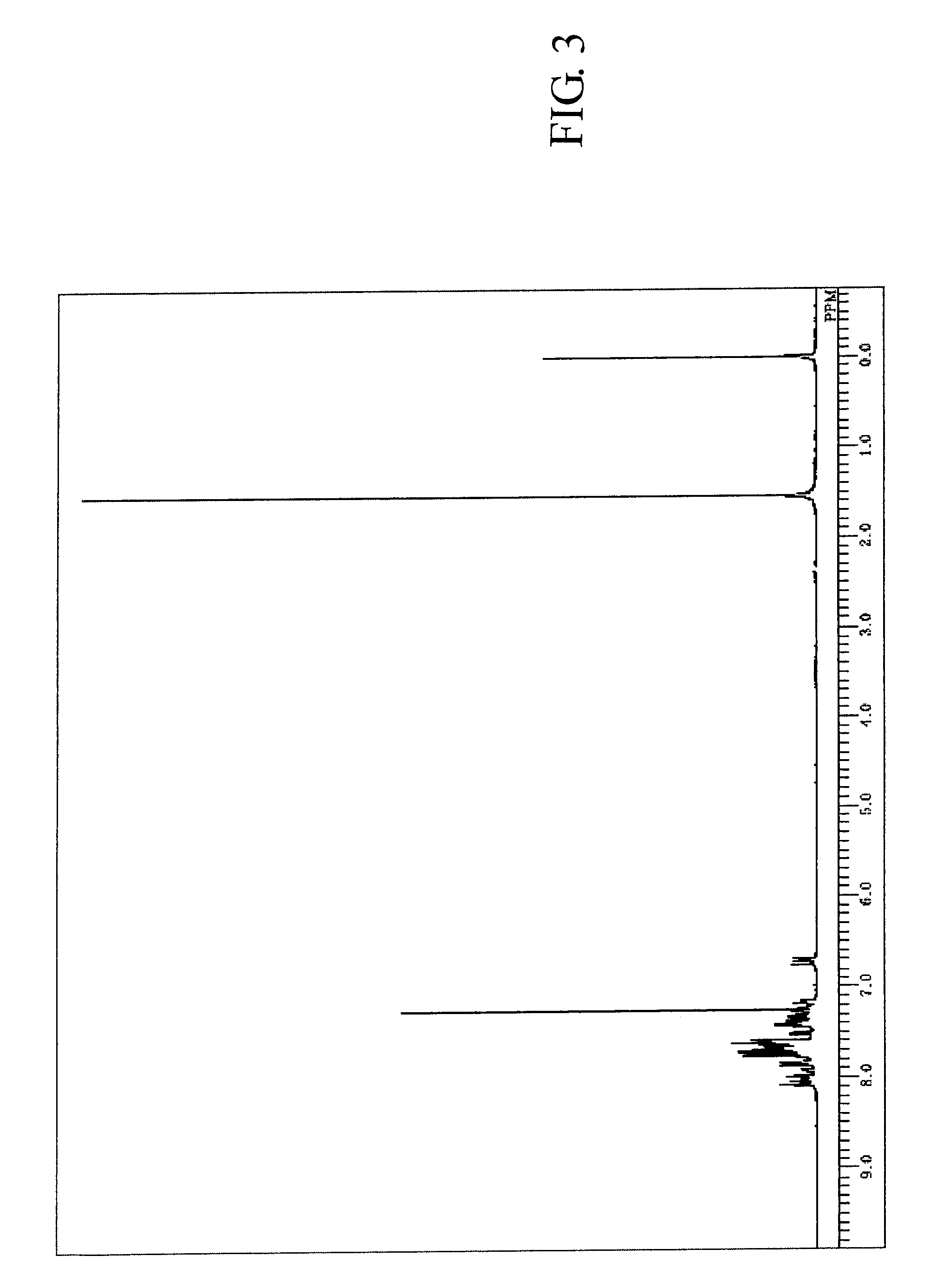Fluoranthene compound, organic electroluminescence device using the same, and solution containing organic electroluminescence material
a technology of fluoranthene and organic electroluminescence, which is applied in the direction of solid-state devices, discharge tubes/lamp details, group 4/14 element organic compounds, etc., can solve the problems of insufficient light emission efficiency and lifetime, and achieve enhanced light emission efficiency, superior luminance of light emission, and long lifetime
- Summary
- Abstract
- Description
- Claims
- Application Information
AI Technical Summary
Benefits of technology
Problems solved by technology
Method used
Image
Examples
synthesis example 1
[0186]FDMS 1-2
(1) Synthesis of 5-bromoacenaphthylene
[0187]Adding 29.2 g (128.7 mmol) of 2,3-dichloro-5,6-dicyano-1,4-benzoquinone (DDQ) to 25.4 g (107.3 mmol) of 5-bromoacenaphthene and 500 ml of dry benzene, the resultant solution was stirred while refluxing under heating for 6 h. Further, adding 6.0 g (26.4 mmol) of DDQ into the reacted mixture, the resultant mixture was stirred under heating for 4 h. After the resultant mixture was cooled by being left standing, precipitates are separated by filtration and washed with chloroform. Gathering the filtrates together, it was washed with 10% sodium hydroxide aqueous solution and water. After the solution was separated, drying the organic layer through anhydrous magnesium sulfate, the solvent was distillated away. The resultant mixture was dried under reduced pressure to obtain 13.0 g (yield: 51.6%) of brown solid being 5-bromoacenaphthylene.
(2) Synthesis of 3-bromo-7,12-dibenzo[k]fluoranthene
[0188]A mixture prepared by adding 14.9 g (5...
synthesis example 2
[0193]FDMS 1-3
[0194]Synthesis Example 2 was carried out in a similar manner as Synthesis Example 1 except that 4-(naphthalen-1-yl)phenyl boronic acid was employed instead of 9,9-dimethyl-9H-fluorene-2-yl boronic acid to obtain 3-(4-(naphthalen-1-yl)phenyl)-7,12-diphenylbenzo[k]fluoranthene (Compound 1-3).
[0195]The measured results of FDMS analysis, ultraviolet absorption peak wavelength λ max (molar absorption coefficient ε) in toluene solution and fluorescent light emission peak wavelength (FL) about the resultant compound are described below. Further, measured result of 1H-NMR spectrum is shown in FIG. 2.
[0196]FDMS, calcd for C48H30=606, found m / z=606 (M+)
[0197]UV(PhMe); λmax, 422 nm (ε 4.35), FL (PhMe, λex=319 nm); λmax, 438 nm
synthesis example 3
[0198]FDMS 1-5
[0199]Synthesis Example 3 was carried out in a similar manner as Synthesis Example 1 except that 4-(10-naphthalen-2-yl)anthracene-9-yl)-phenyl boronic acid was employed instead of 9,9-dimethyl-9H-fluorene-2-yl boronic acid to obtain 3-(4-(10-naphthalen-2-yl)anthracene-9-yl)phenyl)-7,12-diphenylbenzo[k]fluoranthene (Compound 1-5).
[0200]The measured results of FDMS analysis, ultraviolet absorption peak wavelength λmax (molar absorption coefficient ε) in toluene solution and fluorescent light emission peak wavelength (FL) about the resultant compound are described below. Further, measured result of 1H-NMR spectrum is shown in FIG. 3.
[0201]FDMS, calcd for C62H38=782, found m / z=782 (M+)
[0202]UV(PhMe); λmax, 422 nm (ε 4.37), FL (PhMe, λex=317 nm); λmax, 439 nm
PUM
| Property | Measurement | Unit |
|---|---|---|
| thickness | aaaaa | aaaaa |
| thickness | aaaaa | aaaaa |
| light transmittance | aaaaa | aaaaa |
Abstract
Description
Claims
Application Information
 Login to View More
Login to View More - R&D
- Intellectual Property
- Life Sciences
- Materials
- Tech Scout
- Unparalleled Data Quality
- Higher Quality Content
- 60% Fewer Hallucinations
Browse by: Latest US Patents, China's latest patents, Technical Efficacy Thesaurus, Application Domain, Technology Topic, Popular Technical Reports.
© 2025 PatSnap. All rights reserved.Legal|Privacy policy|Modern Slavery Act Transparency Statement|Sitemap|About US| Contact US: help@patsnap.com



